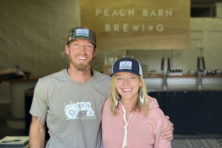Suds with Sophie: German Adjunct Lagers, Part 2
- Share
- Tweet
- Pin
- Share
by SOPHIE NELSON, [email protected]
Part one of this story launched with the May 1 issue of the Peninsula Pulse. Find it online at doorcountypulse.com/suds-with-sophie-german-adjunct-lagers-part-1.
After decades of growth in the popularity of light lagers, the year 1920 brought about a 13-year dark period for American beer with the passing of the 18th Amendment and the beginning of Prohibition. Many breweries disappeared, rebranded to make nonalcoholic beverages or were absorbed by larger brewery operations. In the year 1900, there were 2,000 independent breweries in the United States. By 1934, there were only 750.
Following years of closures and consolidation, eventually a few big players controlled much of the beer-brewing industry. As happens commonly with trends in the marketplace, consumers’ tastes changed and began to favor the cheap, light and carbonated adjunct lagers produced by these large breweries.
Increasingly masking the German roots during the 1940s, the discovery of an enzyme that helps to further break down starches into fermentable sugars led to creating a beer with fewer carbohydrates and calories and introducing a diet or “light” beer. To this day, light-beer brands make up three of the four top-selling beers in the U.S.
A hit to all types of American cuisine came about during the 1950s with the popularity of canned foods, TV dinners, standard supper-club grub and a general loss of flavor and diversity across all food and drink sectors. As you can guess, this trend also hit beer, which had seemed to be preparing for these times accordingly.
By this time, American adjunct lagers had become what we’re familiar with today. Any bitterness that remained from the German lager days had been removed, and more sweetness was added. Extra carbonation was added as well to give a false bite that was missing without hop bitterness. The body became lighter without distinct malt or hop character. Designed to appeal to the masses, beer was less filling, less caloric and less offensive.
The 1960s brought industrialization to the brewing industry, creating mass scales, mass marketing, mass distribution and standardization. In this way, the big breweries got bigger, and the small ones continued to disappear. In 1950, the four largest breweries (Schlitz, Anheuser-Busch, Ballantine and Pabst) controlled just 25 percent of the market. By 1980, the top four breweries had 75 percent of the market, and fewer than 100
breweries existed in the United States. By 2000, the top four (Anheuser-Busch, Miller, Coors and Pabst) controlled 95 percent of the market.
Although this progression follows technological and cultural trends in the U.S., similar changes were occurring across the globe as well. Light lagers are best sellers internationally, and each country developed its own version of this “lawnmower beer” throughout this time: Heineken in the Netherlands, Carlsberg in Denmark, Foster’s in Australia, Singha in Thailand, Stella Artois in Belgium, Red Stripe in Jamaica and so on.
These international lagers aren’t all the same, however, and they developed, as in the U.S., their own distinctive flavors. Japan followed its love of sake and sharp beverages, for example, by creating a light beer called Asahi that’s made crisp and dry with high levels of rice.
But don’t despair, my fellow craft fanatics! The 1960s also brought discontent with the growing trend of mass-produced, similar-tasting, light, fizzy lagers and spurred the craft movement that we’re all enjoying tremendously today.


